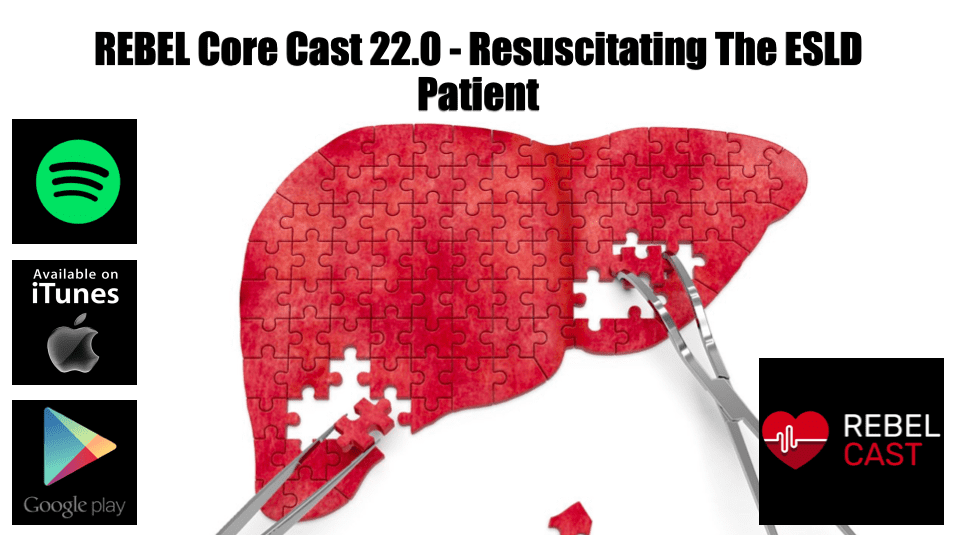
- End stage liver disease patients have fragile baseline physiology. Minor insults can have profound effects
- Always start with the basics – large bore IV lines
- SBP give 3rd generation cephalosporin + albumin in severe disease
- Upper GI bleed give appropriate blood products + ceftriaxone
REBEL Core Cast 22.0 – Decompensated Liver Disease
Click here for Direct Download of Podcast
What does the liver do
- Makes most of macrophages and complement proteins
- Produces clotting factors and fibrinogen and Protein C & S and antithrombin
- Produces albumin – creates oncotic gradient
 Cirrhosis
Cirrhosis
- Represents a late stage of progressive hepatic fibrosis characterized by distortion of the hepatic architecture
- Essential functions of liver compromised – immunocompromised, vasodilated, hyperdynamic cardiac function at baseline. Not healthy patients!!
Things to consider in presentation of cirrhotic patients
-
Consider them all immunocompromised!
- May lack fever, leukocytosis on presentation – presume they’re all sick
-
Ask yourself why they’re coming in
- Increasing ascites – why is it getting bigger?
- Hepatic encephalopathy – don’t just treat elevated ammonia, ask why it’s happening
-
Calculate Shock Index – HR / SBP
- > 0.7 – abnormal
- > 1.0 – worrisome
- Can clue you into patient being hypovolemic before they become hypotensive.
- Note: Many patients are on beta blockers which can mask tachycardia
Access
- These patients can be tough vascular access
- Central line is not your best bet, get short, fat catheters for great flow rates.
- If you can’t get IV access, get an IO in there
Spontaneous bacterial peritonitis
- Suspect in all patients with ascites
- Classic triad of fever, ascites and abdominal pain is rarely present
- New renal failure, diarrhea, hypothermia and acidosis are potential presentations
- 13% will present with no symptoms at all!!
-
Have a low threshold to tap
- >250 PMN is main diagnostic criteria, also send for cultures
-
Management
-
3rd generation cephalosporin (ceftriaxone or cefotaxime)
- Ceftriaxone 25 mg/kg up to 2 gm daily
- Cefotaxime 25 mg/kg up to 1 gm Q8
-
1.5g/kg of albumin
- Benefit of albumin is in patient with severe disease with creatinine >1, BUN > 30 or total bili > 4
- Albumin + Antibiotic had 20% reduction in renal failure and a 25% reduction in mortality
-
3rd generation cephalosporin (ceftriaxone or cefotaxime)
GI Bleed
- Cirrhotic patients develop varices at rate of 5-15% per year
-
Management
- 2 Large Bore IVs
-
Emergency Type O from the beginning
- Call for 4 Units immediately then switch to type specific
- Consider massive transfusion protocol
- O negative for women of child bearing age, O positive for all others
- Send off TEG to help guide resuscitation
-
If no TEG, send Fibrinogen level
- Fibrinogen <100: give cryoprecipitate
-
Secure airway – consider delayed sequence intubation
- Delayed sequence will allow you to preoxygenate, suction and drop NG tube to decompress GI tract
- Ketamine 0.5 mg/kg IV
- Get Blakemore or Minnesota tube ready
- Octreotide and PPI do not affect these patients mortality
-
Give antibiotic!
- Ceftriaxone or other 3rd generation cephalosporin
- NNT of 4 for preventing infection
- NNT of 22 for reducing mortality
Links & Resources:
- REBEL EM: SBP
- REBEL EM: Should you give albumin in SBP
- EMRAP: Paracentesis
- SinaiEM: SBP Pearls
- EMRAP: Placement of Blakemore Tube
Shownotes Written By: Miguel Reyes, MD (Twitter: @miguel_reyesMD)
Post Peer Reviewed By: Salim R. Rezaie, MD (Twitter: @srrezaie)
The post REBEL Core Cast 22.0 – Decompensated Liver Disease appeared first on REBEL EM - Emergency Medicine Blog.


